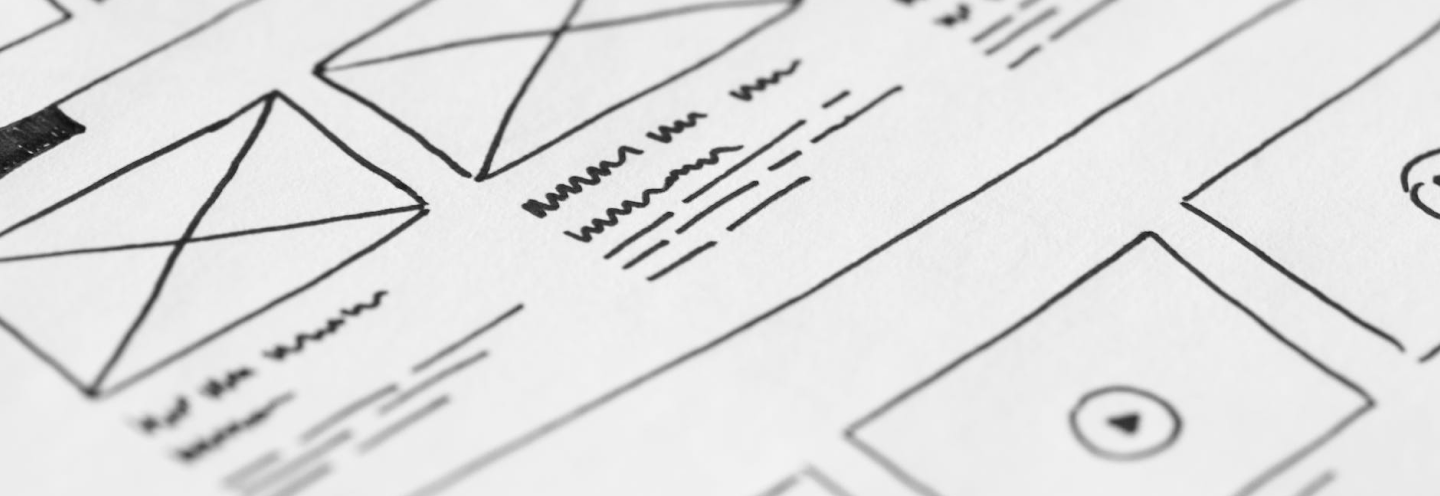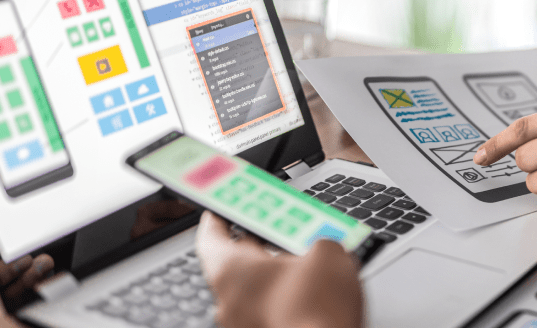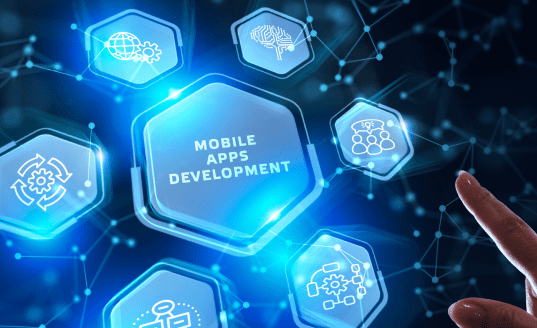Blog
UI/UX Learning Path
December 21, 2022 - 7 min. read

If you’re wondering where to learn UX/UI design, look no further. This learning path includes our team’s favorite articles, e-books, and courses. Completing it will help you learn the key concepts and processes of UX/UI design.
Let’s dive in!
1
UX Design
As Steve Jobs once said, “Design is not just what it looks like and feels like. Design is how it works.” UX or User Experience is how users experience and interact with your product. Below are some beneficial resources for learning the fundamentals of UX design.
- E-book: UX Fundamentals | by UX Design World
- E-book: UX Fundamentals | by GetFeedback
- Article: Data-Driven Design | by Springboard
- E-book: Mobile App UX Principles | by Google
- Article: Nielsen’s 10 Usability Heuristics | by Nielsen Norman Group
- Article: How Users Hold Their Phones | by UX Matters
For further reading, we recommend the following sources:
1
UX Design
As Steve Jobs once said, “Design is not just what it looks like and feels like. Design is how it works.” UX or User Experience is how users experience and interact with your product. Below are some beneficial resources for learning the fundamentals of UX design.
- E-book: UX Fundamentals | by UX Design World
- E-book: UX Fundamentals | by GetFeedback
- Article: Data-Driven Design | by Springboard
- E-book: Mobile App UX Principles | by Google
- Article: Nielsen’s 10 Usability Heuristics | by Nielsen Norman Group
- Article: How Users Hold Their Phones | by UX Matters
For further reading, we recommend the following sources:
2
Design Strategy
In this section, you will learn about multiple key concepts: user-centered design, mobile-first design, responsive design, and typography.
- User-Centered Design
User-centered design is an evolving approach that helps you meet your users’ needs and expectations. It puts users at the heart of the design process. The following articles will introduce you to user-centered design principles.
- Article: Introduction to User-Centered Design | by Usability Geek
- Article: User-Centered Design: Process and Benefits | by UX Planet
- Mobile-First Design & Responsive Design
In an era when smartphones are evolving every day & the internet is accessible 24/7 in the palm of your hand, mobile-first design & responsive design are essential. Use the resources below to learn more about these principles and how to apply them.
- Article: What is Mobile-First Design? | by Vincent Xia
- Article: A Hands-On Guide to Mobile-First Responsive Design | by UXPin
- Article: Mobile-First Design: Full Guide | by Agente Studio
- Article: 21 Best Examples of Effective Mobile Website Design | by Impact
- Article: 21 of the Best Examples of Mobile Website Design | by Hubspot
- Typography Standards
If users can’t easily read your content, they will simply abandon your product. That’s why typography is an integral part of UX/UI design. Check out the resources below to learn the key principles of typography.
- Course: Typography Master Class for UI/UX Designers | by Alexunder Hess
- Article: The UX Designer’s Guide to Typography | by IxDF.
- Article: Optimal Font Size for Web Pages | by Pielot
P.S. We highly recommend the master class; it’s a game-changer.
2
Design Strategy
In this section, you will learn about multiple key concepts: user-centered design, mobile-first design, responsive design, and typography.
- User-Centered Design
User-centered design is an evolving approach that helps you meet your users’ needs and expectations. It puts users at the heart of the design process. The following articles will introduce you to user-centered design principles.
- Article: Introduction to User-Centered Design | by Usability Geek
- Article: User-Centered Design: Process and Benefits | by UX Planet
- Mobile-First Design & Responsive Design
In an era when smartphones are evolving every day & the internet is accessible 24/7 in the palm of your hand, mobile-first design & responsive design are essential. Use the resources below to learn more about these principles and how to apply them.
- Article: What is Mobile-First Design? | by Vincent Xia
- Article: A Hands-On Guide to Mobile-First Responsive Design | by UXPin
- Article: Mobile-First Design: Full Guide | by Agente Studio
- Article: 21 Best Examples of Effective Mobile Website Design | by Impact
- Article: 21 of the Best Examples of Mobile Website Design | by Hubspot
- Typography Standards
If users can’t easily read your content, they will simply abandon your product. That’s why typography is an integral part of UX/UI design. Check out the resources below to learn the key principles of typography.
- Course: Typography Master Class for UI/UX Designers | by Alexunder Hess
- Article: The UX Designer’s Guide to Typography | by IxDF.
- Article: Optimal Font Size for Web Pages | by Pielot
P.S. We highly recommend the master class; it’s a game-changer.
3
UI Design
The UI or User Interface is what the user sees and interacts with. It holds the visual hierarchy, colors, fonts, icons, images, buttons, and more. Although UX design comes first, UI and UX design are interrelated; they work together and impact one another. So now that we’ve covered the basics of UX design, let’s learn about UI design.
- Article: Web Design Standards in 2020 | by Sisson Media
- Article: 13 Website Design Best Practices For 2021 | by Quick Sprout
- Article: UI Design Do’s & Dont’s | by Apple
- Article: 125+ Best Practices in UX/UI | by Nick Kolenda
- Article: The Difference Between UI & UX | by UX Planet
- E-book: A Contemporary Landscape for Digital Thinkers: Volume 2 | by Awwwards
3
UI Design
The UI or User Interface is what the user sees and interacts with. It holds the visual hierarchy, colors, fonts, icons, images, buttons, and more. Although UX design comes first, UI and UX design are interrelated; they work together and impact one another. So now that we’ve covered the basics of UX design, let’s learn about UI design.
- Article: Web Design Standards in 2020 | by Sisson Media
- Article: 13 Website Design Best Practices For 2021 | by Quick Sprout
- Article: UI Design Do’s & Dont’s | by Apple
- Article: 125+ Best Practices in UX/UI | by Nick Kolenda
- Article: The Difference Between UI & UX | by UX Planet
- E-book: A Contemporary Landscape for Digital Thinkers: Volume 2 | by Awwwards
4
Android vs. iOS Design 
When it comes to mobile app design, we follow different rules for iOS than for Android. The design rules for iOS were established by Apple and are called the “human interface guidelines.” Meanwhile, Android’s design rules were created by Google and are referred to as the “material design guidelines.” Following these rules allows us to design more intuitive experiences for the users of each operating system.
5
Animation Design 
In part 5, you will learn about UI animation and how it can improve your prototype presentations.
- Article: UI Animation: A Complete Guide for Beginners | by Career Foundry
- Course: Motion UI Design Master Class | by Alexunder Hess
- Article: Animation that Matters | by UX Planet
- Article: Animation Guidelines for UX Design | by Prototypr
- Article: The Ultimate Guide to Animation in UX | by Taras Skytsky
6
Microinteractions 
Do you know the confirmation sound your phone makes when you lock your screen? That’s an example of a micro-interaction. These are small actions that have a huge impact on the user experience! Check the links below to learn about designing micro-interactions.
7
Design Tools
Below are some resources to help you master Figma – one of the best UI design tools available.
- Tutorial: The Basics of Figma
- Tutorial: Prototyping in Figma
- Library: Figma Community
- Library: Figma on YouTube
- Course: Advanced Figma Masterclass | by Alexunder Hess
- Course: Efficient Designer Masterclass | by Alexunder Hess
7
Design Tools
Below are some resources to help you master Figma – one of the best UI design tools available.
- Tutorial: The Basics of Figma
- Tutorial: Prototyping in Figma
- Library: Figma Community
- Library: Figma on YouTube
- Course: Advanced Figma Masterclass | by Alexunder Hess
- Course: Efficient Designer Masterclass | by Alexunder Hess
Conclusion
We hope you enjoy your UX/UI design journey. This learning path covers the basics, but the tech industry is always evolving, and there is always room for improvement, so get ready for an endless, enjoyable learning process.





